Guest post by Sarah Wagner.
Sarah has lived in the Grand Rapids metro area her entire life, and was raised Catholic. She has a passion for local history, and after learning about her ancestral ties to the Basilica of Saint Adalbert she became interested in researching historic Catholic churches. She recently landed her dream job in the Local History department of the Grand Rapids Public Library, where she gets paid to work in the archives and assist patrons researching local history. She often travels to Detroit to hang out with her friends from her online home at Icrontic.com, where she serves as Official Sexy Librarian.
The Basilica of St. Adalbert, Grand Rapids, Michigan
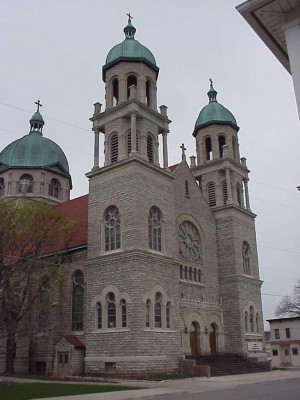 Here is a picture of my church, the Basilica of St. Adalbert, courtesy of their website.A year and a half ago I did a research project covering the history of my church in Grand Rapids, Michigan, The Basilica of Saint Adalbert.
Here is a picture of my church, the Basilica of St. Adalbert, courtesy of their website.A year and a half ago I did a research project covering the history of my church in Grand Rapids, Michigan, The Basilica of Saint Adalbert.
My great-grandparents were married in that church when they came to the United States from Poland. They traveled to Grand Rapids to stay with friends and were married in 1910 in the first Polish church in Grand Rapids.
My mother and I did the research to discover which church they were married in; we fell in love with St. Adalbert's and have been members ever since.
The architecture is breathtaking, the Basilica is full of a rich history, and the parishioners are very welcoming. Listening to the beautiful choir sing from the loft sounds like angels singing on Sunday mornings.
The Basilica of St. Adalbert was built in 1913 and named a minor basilica by Pope John Paul II in 1980, making it the only basilica in Michigan, and of only a few in the United States.
Detroit Catholic Churches
My research paper also discussed how our Basilica was different from a couple of specific Catholic churches in Detroit. I recently made a special trip to certain areas of Detroit to see and take pictures of some historic churches I had read about and was told about by my Michigan History professor. What an adventure it was!
Sweetest Heart of Mary
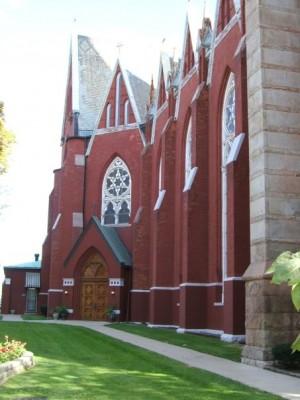 Sweetest Heart of Mary. This church has been kept in good condition. This side faces a beautiful courtyard.The first church we went to visit was the Sweetest Heart of Mary Catholic Church, located at 4440 Russell Street. It is an important church to the Polish community of Detroit, built in 1892, and is still used extensively for masses, weddings, and events.
Sweetest Heart of Mary. This church has been kept in good condition. This side faces a beautiful courtyard.The first church we went to visit was the Sweetest Heart of Mary Catholic Church, located at 4440 Russell Street. It is an important church to the Polish community of Detroit, built in 1892, and is still used extensively for masses, weddings, and events.
It was in much better condition than many of the other churches I visited, although some restoration was still needed. This church is also a Michigan Historic Site, and the windows of the church won prizes at the 1893 Chicago Columbian Exposition and contains one of the oldest Austin organs in existence.
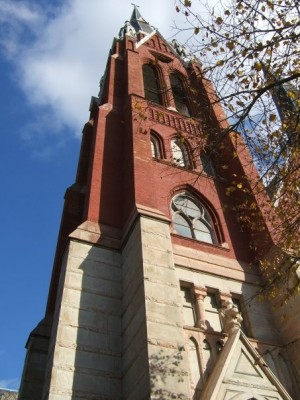 One of the bell towers of Sweetest Heart of Mary.
One of the bell towers of Sweetest Heart of Mary.
St. Albertus
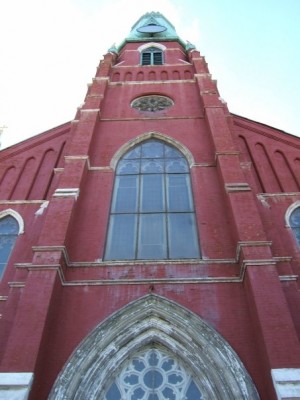 St. Albertus, Detroit's first Polish Catholic church. This church and neighborhood have seen much better days.The second church we visited was St. Albertus, at 4231 St. Aubin Street. St. Albertus was founded in 1872, with the present Gothic Revival church built in 1885, as the first Polish Catholic church in Detroit. The church was closed by the Archdiocese in 1990, although it is named a Michigan Historic Site as well.
St. Albertus, Detroit's first Polish Catholic church. This church and neighborhood have seen much better days.The second church we visited was St. Albertus, at 4231 St. Aubin Street. St. Albertus was founded in 1872, with the present Gothic Revival church built in 1885, as the first Polish Catholic church in Detroit. The church was closed by the Archdiocese in 1990, although it is named a Michigan Historic Site as well.
The church was in one of the worst neighborhoods I have ever been in, as there were vacant and condemned buildings all around. The St. Albertus School looked like it has been vacant for several years. They still hold monthly mass at the church and hold tours and other events, as the church has such a rich history.
Ste. Anne de Detroit
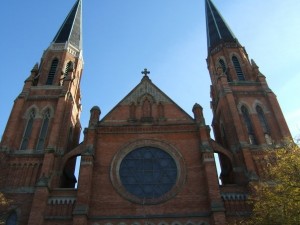 Ste. Anne de Detroit, Detroit's first Church, established the same year as Detroit. It is a beautiful church with a gorgeous courtyard area.
Ste. Anne de Detroit, Detroit's first Church, established the same year as Detroit. It is a beautiful church with a gorgeous courtyard area.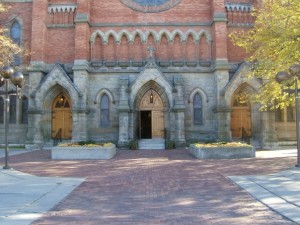 The front doors to Ste. Anne de Detroit. This structure was built in 1886, and one of the priests is buried under the main altar.The third church we visited was Ste. Anne de Detroit Catholic Church, at 1000 Ste Anne, which was the first church founded in Detroit in 1701, only two days after Detroit founder Antoine de la Mothe Cadillac came to Detroit and began to build Fort Ponchartrain.
The front doors to Ste. Anne de Detroit. This structure was built in 1886, and one of the priests is buried under the main altar.The third church we visited was Ste. Anne de Detroit Catholic Church, at 1000 Ste Anne, which was the first church founded in Detroit in 1701, only two days after Detroit founder Antoine de la Mothe Cadillac came to Detroit and began to build Fort Ponchartrain.
This church is amazing and has a rich history. It is near the Ambassador Bridge to Canada, and the church continues to thrive in the lively Hispanic community. They hold regular mass, in both English and Spanish.
St. Stanislaus
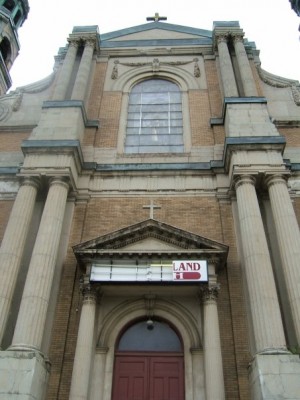 The façade of St. Stanislaus, with a partial Promise Land Baptist church sign. This was the fifth Polish Catholic church in the city of Detroit.The last stop was another Polish Catholic church, St. Stanislaus. It is located just south of Hamtramck, near the intersection of I-94 and I-75. St. Stanislaus was formed in 1898 to relieve overcrowding at St. Albertus.
The façade of St. Stanislaus, with a partial Promise Land Baptist church sign. This was the fifth Polish Catholic church in the city of Detroit.The last stop was another Polish Catholic church, St. Stanislaus. It is located just south of Hamtramck, near the intersection of I-94 and I-75. St. Stanislaus was formed in 1898 to relieve overcrowding at St. Albertus.
The baroque structure was built in 1911. During the years after World War II, the demographics drastically changed in the neighborhood surrounding St. Stanislaus, with the flight of young couples and wealthy families—as well as the tragedy of I-94 bisecting the neighborhood, which displaced families and businesses.
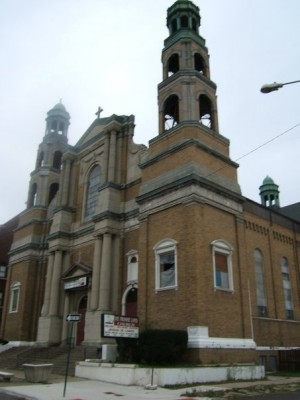 Another view of St. Stanislaus, showing missing windows. A heartbreaking sight to see.The parish closed in 1989 and the church of St. Stanislaus now houses The Promise Land Missionary Baptist Church.
Another view of St. Stanislaus, showing missing windows. A heartbreaking sight to see.The parish closed in 1989 and the church of St. Stanislaus now houses The Promise Land Missionary Baptist Church.
When visiting the church, we noticed that the Baptist Church is only using the basement, as heating the sanctuary would be expensive, and many of the stained glass windows are missing, broken or damaged. Seeing this church was very disheartening to me. This church used to be thriving along with the Detroit Polish Catholic population.
As with much of Detroit, devastating occurrences led to many people leaving for the suburbs, leaving behind cherished memories without looking back.
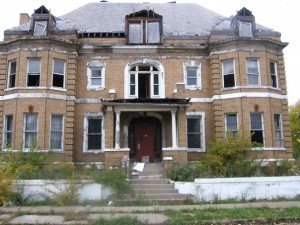 An image of the old deteriorating St. Stanislaus Rectory, with broken windows, missing trim, damaged roof, and damaged bricks. There was a photo uploaded to Flickr two years prior to this photo, and it was in pristine condition. Things sure change quickly.The St. Stanislaus church structure has very few stained glass windows remaining, and the roof is damaged. The church rectory is abandoned with the trim around the windows and along the roof being missing, all of the windows are broken, and there is graffiti covering the rear of the building.
An image of the old deteriorating St. Stanislaus Rectory, with broken windows, missing trim, damaged roof, and damaged bricks. There was a photo uploaded to Flickr two years prior to this photo, and it was in pristine condition. Things sure change quickly.The St. Stanislaus church structure has very few stained glass windows remaining, and the roof is damaged. The church rectory is abandoned with the trim around the windows and along the roof being missing, all of the windows are broken, and there is graffiti covering the rear of the building.
There are few funds to maintain this church, as the Baptist church has a much smaller community than the original Catholic community this church was built and intended for. It would be interesting to see how it would look like today if the history of Detroit had been different.
Grand Rapids and Detroit
It is difficult to come up with a fair comparison between Catholic churches in Grand Rapids to those in the city of Detroit. Detroit's history is complex and very different from that of Grand Rapids.
Grand Rapids did not have flight of young and wealthy families on the scale that Detroit had. Many families in Grand Rapids have still moved out of the inner city, yet parishioners of the Basilica of St. Adalbert continue to drive downtown to attend the church of their ancestors. The parishioners of the Basilica of St. Adalbert haven't all fled from their memories and family history, and the neighborhood surrounding the church isn't frightening. As long as the neighborhood continues to be safe, parishioners will still attend mass at the lovely Basilica of St. Adalbert. I hope to continue attending for years to come.